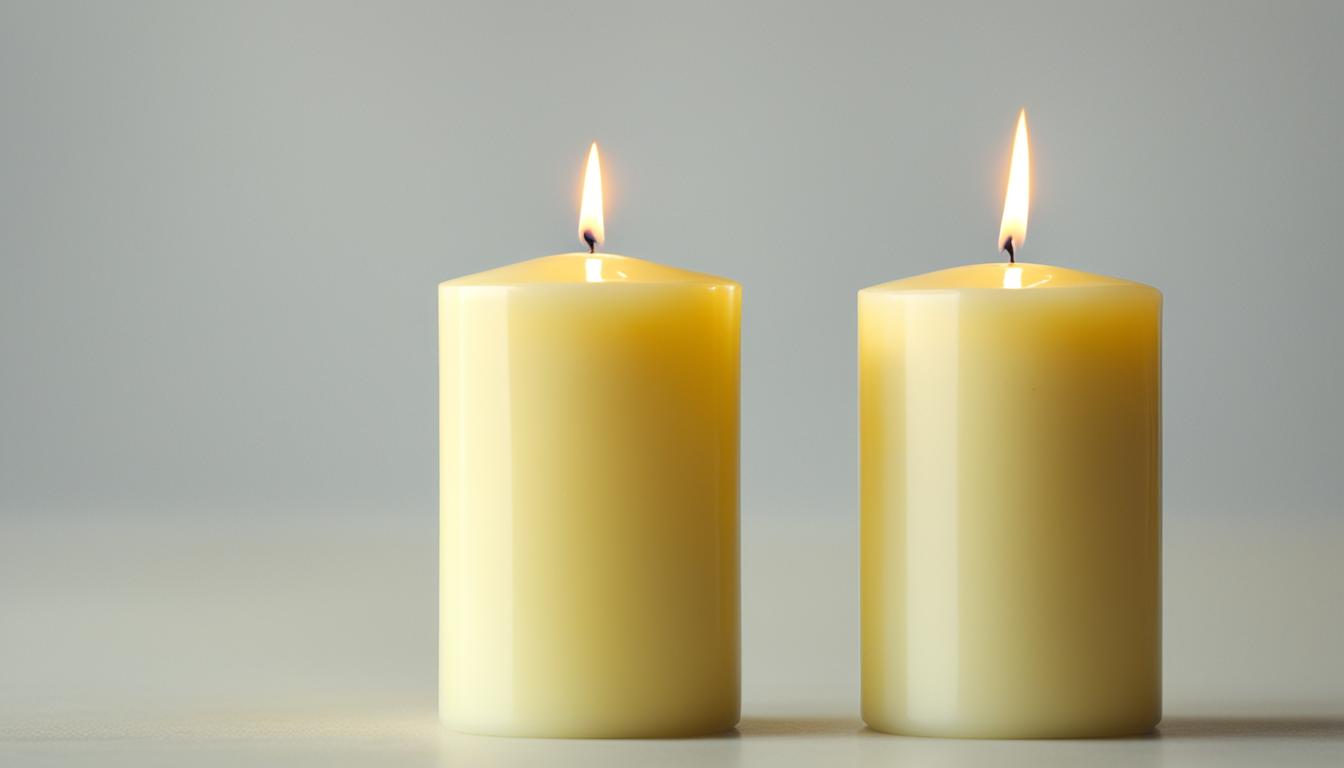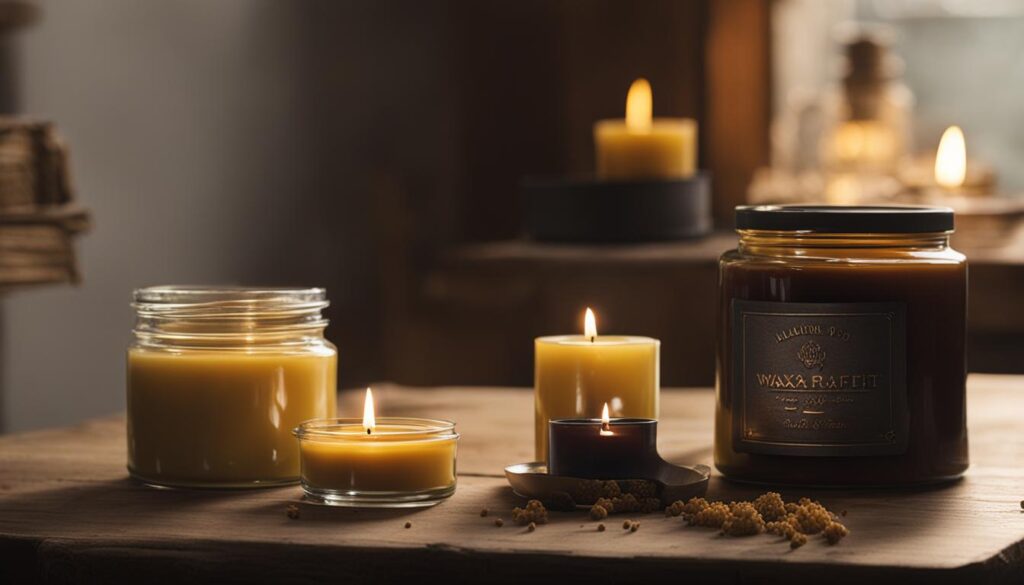Paraffin vs Soy vs Beeswax: The Definitive Candle Wax Comparison

What is the Best Candle Wax for Your Candlemaking
Have you been stuck trying to figure out the best wax to use for your candlemaking? With so many options available, it can be overwhelming to choose the right one. But fret not, we’re here to help you make an informed decision!
In this comprehensive guide, we will compare three popular types of candle wax: paraffin, soy, and beeswax. Whether you’re a seasoned candlemaker or just starting out, understanding the differences between these waxes can greatly enhance your candlemaking experience.
We’ll delve into their history and origins, exploring their unique properties, environmental impact, health and safety considerations, performance and quality, cost analysis, crafting possibilities, consumer preferences, and expert opinions. By diving into the virtues and limitations of each wax, you’ll be equipped to choose the best candlemaking wax for your needs.
So, if you’re tired of trial and error and want to create candles that stand out in quality and aroma, keep reading. Discover the benefits and characteristics of paraffin, soy, and beeswax, and take your candlemaking skills to the next level.
Introduction
Candle wax is more than just a fuel for candles; it plays a crucial role in determining a candle’s burning time, scent throw, and overall performance. Choosing the right wax for your candlemaking projects is essential to achieve the desired results. In this section, we will provide an overview of the different types of candle wax and highlight the importance of selecting the appropriate wax for your specific needs.
To give you a comprehensive understanding of the various wax options available, we will focus on three main types: paraffin, soy, and beeswax. These waxes differ in their characteristics, origins, and environmental impact. By exploring the differences between these waxes, you can make an informed decision about which one is best suited for your candlemaking endeavors.
History and Origins
Understanding the history and origins of different types of candle wax can provide valuable insights into their characteristics and uses. In this section, we will explore the origins of paraffin, soy, and beeswax, including their historical significance and how they have been used in candlemaking throughout the centuries. We will also discuss the development of each wax and how it has evolved over time.
Candles have been used for various practical and symbolic purposes for thousands of years. The earliest evidence of candle-like objects dates back to ancient Egypt and Mesopotamia, where torches made from reeds and wicks soaked in flammable liquids were used. However, true candlemaking as we know it today began to emerge during the Roman era.
The Romans are credited with developing the first recognizable candle, known as “cereus.” These candles were made from tallow, a rendered animal fat, which was poured into molds with a central wick. The name “cereus” comes from the Latin word for wax, reflecting the eventual transition from tallow to beeswax as the preferred Candlemaking material.
“The Romans were pioneers in candlemaking, introducing the concept of a central wick surrounded by a solid substance that would serve as both fuel and light. This innovation laid the foundation for the future development of various candle waxes.”
During the Middle Ages, beeswax candles gained popularity due to their clean-burning properties and pleasant aroma. Beeswax was a valuable substance and often used in religious ceremonies and for lighting in wealthy households. However, beeswax was expensive and not readily accessible to the general population, leading to the search for alternative materials.
In the 19th century, paraffin wax, a byproduct of petroleum refining, emerged as a widely available and affordable candle wax. Paraffin candles became the most common type in many households due to their low cost and easy production. Paraffin offered a longer burn time and a more economical alternative to beeswax, leading to a decline in its popularity.
The rise of environmental consciousness in recent decades has led to the development of soy wax as a sustainable alternative. Soy candles gained popularity mainly due to their renewable source, clean-burning nature, and compatibility with fragrances and dyes. Soy wax also has a lower melting point than paraffin or beeswax, which allows for better scent throw and faster fragrance release.
Overall, the history and evolution of paraffin, soy, and beeswax showcase the continuous pursuit of better candlemaking materials, driven by factors such as cost, availability, environmental considerations, and consumer preferences.
Physical and Chemical Properties
Understanding the physical and chemical properties of candle wax is crucial for achieving desired results in candlemaking. In this section, we will explore the specific characteristics of paraffin, soy, and beeswax, which play a significant role in determining the performance and quality of the candles produced.
Firstly, let’s consider the melting points of these waxes. Paraffin wax has a relatively low melting point, making it easy to work with and ideal for container candles. Soy wax, on the other hand, has a slightly higher melting point, which can result in longer burn times. Beeswax has the highest melting point among the three, ensuring excellent heat resistance and stability.
Another essential characteristic is fragrance retention. Soy wax has excellent fragrance-holding properties, allowing for a robust and long-lasting scent throw in candles. Paraffin wax also retains fragrances well, making it a popular choice for scented candles. Beeswax has a naturally sweet aroma and a more subtle scent throw, which is favored by those who prefer a milder fragrance in their candles.
The burn time of a candle is influenced by the wax used. Paraffin wax typically offers a longer burn time, making it a cost-effective option. Soy wax burns slower, contributing to extended candle life. Beeswax, with its dense composition, boasts an even longer burn time and produces a bright, steady flame.
Aesthetic appeal is an important consideration for many candlemakers. In terms of appearance, paraffin wax can be easily dyed to achieve vibrant colors and a smooth, glossy finish. Soy wax has a natural creamy appearance and is popular for creating a more rustic, textured look. Beeswax has a distinctive golden hue and a unique, organic texture that adds a touch of natural beauty to candles.
Pro Tip: Experiment with different wax types to find the perfect balance of melting point, fragrance retention, burn time, and appearance that aligns with your candlemaking goals and creative vision.
Now, let’s visualize a comprehensive comparison of the physical and chemical properties of paraffin, soy, and beeswax in the table below:
| Candle Wax Type | Melting Point | Fragrance Retention | Burn Time | Appearance |
|---|---|---|---|---|
| Paraffin Wax | Low | Good | Long | Smooth and glossy |
| Soy Wax | Slightly higher | Excellent | Slow | Creamy and rustic |
| Beeswax | High | Moderate | Very long | Golden and organic |
By considering these physical and chemical properties, you can make informed decisions on which wax type best suits your specific candlemaking needs and desired outcomes.
Environmental Impact and Sustainability
In today’s world, the environmental impact and sustainability of our choices are paramount. As candlemakers and consumers, it’s essential to consider the effects of our candle wax on the planet. In this section, we will explore the environmental implications of using paraffin, soy, and beeswax and examine their renewable or non-renewable nature, carbon emissions, waste generation, and pollution potential.
When it comes to paraffin wax, it’s important to note that it’s derived from petroleum, a non-renewable fossil fuel. This extraction process contributes to carbon emissions and the depletion of finite resources. Additionally, the burning of paraffin candles releases soot and potentially harmful volatile organic compounds (VOCs) into the air.
Soy wax, on the other hand, offers a more sustainable alternative. It is made from soybean oil, a renewable resource that can be cultivated without depleting the environment. Soy wax candles tend to have lower carbon emissions compared to paraffin candles. However, it’s crucial to consider the sustainability of soybean farming practices, such as deforestation or pesticide use.
Beeswax, obtained from honeycomb, is another eco-friendly option. It is a natural byproduct of beekeeping and does not require synthetic processing. Beeswax candles have a minimal carbon footprint and do not release harmful chemicals when burned. Furthermore, supporting beekeeping promotes pollination and the health of bee populations, which are crucial for ecological balance.
For environmentally conscious candlemakers, sustainable candlemaking practices are gaining traction. This involves using renewable waxes, like soy and beeswax, as well as incorporating eco-friendly packaging and ensuring responsible sourcing of ingredients. Additionally, exploring alternative wax options, such as coconut or palm wax, can further reduce environmental impact.

Health and Safety Considerations
The health and safety of candlemakers and users should always be a top priority. When working with different types of candle wax, it is essential to be aware of the potential health hazards and safety precautions. This section will discuss the health considerations associated with paraffin, soy, and beeswax, as well as provide recommendations for safe handling and usage.
When burning candles, certain wax types like paraffin can release Volatile Organic Compounds (VOCs) and soot into the air. VOCs can contribute to indoor air pollution and may cause respiratory irritation or trigger allergies and asthma in sensitive individuals. Additionally, the soot emitted by burning candles can accumulate on surfaces and contribute to indoor pollution.
Here are some safety precautions to consider:
- Make sure the room is well-ventilated when burning candles.
- Trim candle wicks to 1/4 inch to minimize soot production.
- Avoid burning candles for extended periods and never leave them unattended.
- Keep burning candles away from flammable objects and out of reach of children and pets.
- Consider using candle containers or holders that can catch any possible wax spills.
It’s also important to note that some individuals may be more sensitive to certain types of wax or fragrances. If you or someone in your household has allergies or respiratory conditions, you may want to consider using soy or beeswax candles, as they are generally considered to have fewer potential health risks.
Always follow the manufacturer’s instructions and guidelines when working with candle wax, and consult with a medical professional if you have any concerns about specific health conditions or sensitivities.
Performance and Quality in Candle Making
The performance and quality of candles are the ultimate indicators of a candle wax’s effectiveness. To assess which wax produces the best results, we will evaluate the burning characteristics, scent throw, and overall performance of paraffin, soy, and beeswax candles.
Burning Characteristics: The way a candle burns can significantly impact its performance. Some of the key aspects to consider include the burn time, flame stability, and the absence of smoking or tunneling. Paraffin wax tends to have a more consistent burn and produces a steady flame. Soy wax often has a longer burn time and can maintain an even melt pool, reducing the risk of tunneling. Beeswax generally has a slower burn rate, creating a longer-lasting candle.
Scent Throw: The scent throw refers to the candle’s ability to release fragrance into the surrounding space. Paraffin wax has excellent scent throw capabilities, as it can hold a significant amount of fragrance oil. Soy wax also has a good scent throw, but it may require a higher fragrance load to achieve the same level of intensity. Beeswax, known for its natural scent, has a subtle fragrance throw that is perfect for those who prefer a more delicate aroma.
Overall Performance: In terms of overall performance, each wax type has its strengths. Paraffin wax is highly versatile and can be easily molded into different shapes and sizes. Soy wax is known for its clean burn and eco-friendly nature, making it appealing to environmentally conscious consumers. Beeswax offers a natural and traditional option, with its characteristic warm glow and subtle honey scent.
Factors such as wick selection, fragrance load, and container compatibility can also influence the performance and quality of candles. Choosing the right wick for the wax type is crucial to ensure optimal burning. A fragrance load that is appropriate for the specific wax helps achieve the desired scent intensity. Furthermore, considering the compatibility between the wax and the candle container can prevent potential issues such as cracking or leaking.
By carefully evaluating the burning characteristics, scent throw, and overall performance of paraffin, soy, and beeswax candles, you can determine which wax is best suited for your specific candlemaking needs.
Cost Analysis and Accessibility
When it comes to candlemaking, cost and accessibility are important factors to consider when choosing the right wax. In this section, we will compare the cost and accessibility of three popular types of candle wax: paraffin, soy, and beeswax.
Let’s start by looking at the cost of each wax. The price of wax can vary depending on factors such as raw material prices, production processes, and market demand. Paraffin wax is known for being the most affordable option, making it popular among candlemakers on a budget. Soy wax is typically priced higher than paraffin due to its renewable and eco-friendly nature. Beeswax, being a premium and natural wax, tends to be the most expensive option. It’s important to consider your budget and the value you place on sustainability and eco-consciousness when making your decision.
In terms of accessibility, all three waxes are widely available for purchase. Paraffin wax can be found in many craft stores and online retailers, making it easily accessible for most candlemakers. Soy wax has also gained popularity and can be found in various locations, including specialty candle supply stores and online platforms. Beeswax, although less commonly available than paraffin and soy, can still be sourced through specialty suppliers and local beekeepers.
It’s worth noting that depending on your location and specific needs, the accessibility of each wax type may vary. It’s recommended to explore different suppliers and online marketplaces to find the best options for your candlemaking endeavors.
Consider the cost and accessibility factors alongside other considerations such as your desired candle’s performance, fragrance retention, and environmental impact when selecting the ideal wax for your projects.
Crafting and Creative Considerations
Candlemaking is an art form that allows you to unleash your creativity while producing beautiful and unique candles. The choice of wax is a crucial factor that can greatly influence the outcome of your creations. In this section, we will explore the crafting and creative considerations of using paraffin, soy, and beeswax for your candlemaking projects.
When it comes to different types of candles, each wax has its own unique qualities that make it suitable for specific applications. Paraffin wax, for example, is well-known for its versatility and ability to hold vibrant colors, making it ideal for creating decorative pillar candles. On the other hand, soy wax offers a natural and clean-burning option, perfect for container candles that emit a warm and inviting glow. Beeswax, with its natural honey scent and beautiful golden hue, is often chosen for creating traditional and elegant taper candles.
Another important consideration when working with candle wax is its compatibility with various fragrances and dyes. Some waxes may have better scent throw, allowing the fragrance to fill the room more effectively, while others may have limitations in terms of the types of fragrances they can hold. Similarly, certain waxes may absorb dyes better, resulting in vibrant and long-lasting colors.

When it comes to artistic techniques, different waxes offer unique opportunities. Layering is a popular technique where different colored wax layers are poured to create a visually striking effect. Soy wax, known for its excellent adhesion, is often used for achieving clean and distinct layers. Beeswax, with its natural pliability, is well-suited for sculpting and carving, enabling intricate designs on the surface of your candles. Marbling, another artistic technique, can be accomplished using various waxes to create swirling patterns and interesting visual textures.
To achieve the desired results with each wax type, here are a few tips and recommendations:
- Experiment with different waxes and combinations to find the perfect fit for your creative vision.
- Ensure that the fragrances and dyes you use are compatible with the wax you choose.
- Consider the melting point of each wax and how it may affect the artistic techniques you want to employ.
- Take advantage of the unique characteristics of each wax to create candles with a distinct look and feel.
- Don’t be afraid to push the boundaries and explore new techniques or combinations to unleash your creativity.
By considering these crafting and creative aspects, you’ll be able to elevate your candlemaking skills and create stunning candles that reflect your unique style and artistic expression.
Consumer Preferences and Market Trends
Understanding consumer preferences and market trends can help candlemakers stay competitive and meet the demands of their target audience. In the ever-evolving candle industry, it’s crucial to stay up to date with the latest trends and adapt your product offerings accordingly. Let’s explore the current market landscape and consumer preferences for paraffin, soy, and beeswax candles.
The candle market has witnessed a significant shift towards natural and eco-friendly products. Consumers are increasingly conscious of the environmental impact of their purchases, seeking out candles made from renewable and sustainable materials. As a result, there has been a surge in the popularity of soy and beeswax candles, which are perceived as more environmentally friendly alternatives to traditional paraffin candles.
In addition to sustainability, factors such as fragrance selection, burn time, and visual appeal influence consumer purchasing decisions. Fragrance plays a vital role in candle selection, with consumers gravitating towards candles that offer a wide range of enticing scents. Long burn times are also desirable, as they provide extended enjoyment of the candle’s aroma and ambiance.
When it comes to aesthetics, consumers appreciate visually appealing candles that complement their home decor. The ability to customize candles with different colors, designs, and container options enhances the overall buyer experience.
To cater to niche markets and meet the diverse needs of consumers, candlemakers have been exploring specialty products. This includes offering organic or vegan candles, unique fragrance combinations, and limited-edition collections. By tapping into these niche markets, candlemakers can differentiate their products and appeal to specific consumer segments.
To summarize, consumer preferences in the candle industry are leaning towards natural, eco-friendly options with attractive fragrances, long burn times, and visually appealing designs. Crafters who adapt to these market trends and consumer preferences will be well-positioned to meet the demands of their target audience and succeed in this competitive industry.
Expert Opinions and Case Studies
When it comes to selecting the best candlemaking wax, it’s essential to consider the insights of industry experts and learn from real-life case studies. By understanding the experiences and expertise of professionals in the field, you can gain valuable knowledge to optimize your own candlemaking practices.
Industry professionals emphasize the versatility and performance of paraffin wax. According to Jennifer Thompson, a renowned fragrance development specialist, paraffin wax has outstanding fragrance retention and burn characteristics, making it ideal for scented candles. Thompson further explains how paraffin’s ability to blend with a wide range of fragrances and dyes allows for endless creative possibilities.
On the other hand, candlemakers like Sarah Rodriguez advocate for the use of soy wax. Rodriguez highlights the eco-friendly nature of soy wax, which appeals to environmentally conscious consumers. She also notes that soy wax has a clean and long-lasting burn, resulting in minimal soot and a healthier indoor air quality.
Furthermore, case studies have shown the remarkable qualities of beeswax. In a study conducted by the Candle Research Center, beeswax candles were found to emit negative ions when burned. These ions are said to improve air quality and create a more relaxing ambiance. Many consumers also appreciate the natural golden hue and subtle honey scent of beeswax candles, as shared by Janet Lee, a dedicated artisan candlemaker.
FAQ
What are the different types of candle wax?
What is paraffin wax?
What is soy wax?
What is beeswax?
How do the physical and chemical properties of candle wax affect its performance?
What are the environmental implications of using different types of candle wax?
Are there any health and safety considerations when using different types of candle wax?
How do paraffin, soy, and beeswax candles perform in terms of burning characteristics, scent throw, and overall quality?
Which type of candle wax is the most cost-effective and accessible?
Can different types of candle wax affect the creative outcome of candles?
What are current consumer preferences and market trends for different types of candle wax?
Are there any expert opinions or case studies on the use of different types of candle wax?
Source Links
- Fragrance That Wows: A Beginner’s Guide to Adding Scents to Your Homemade Candles
- best essential oils for candles
- wood wick guide
- how to make candles smell stronger
- how to ship candles
- how to fix soy wax frosting
- wick Guide how to choose the right wick size with chart
- how to make candle molds
- how to clean candle wax
- how to reuse candle jars
- soy wax candle troubleshooting
- best wax melter for candle making
- how to conduct burn test
- why candle flickering crackling smoking
- how much wax per candle
- how to make candles smell stronger
- Easy Ways to Increase the Scent Throw of Your DIY Candles
- How to Make Candles for Meditation and Relaxation
- Using Upcycled Materials in Candle Making
- How to Make Hand-Poured Candles: Tips and Techniques

Leave a Reply